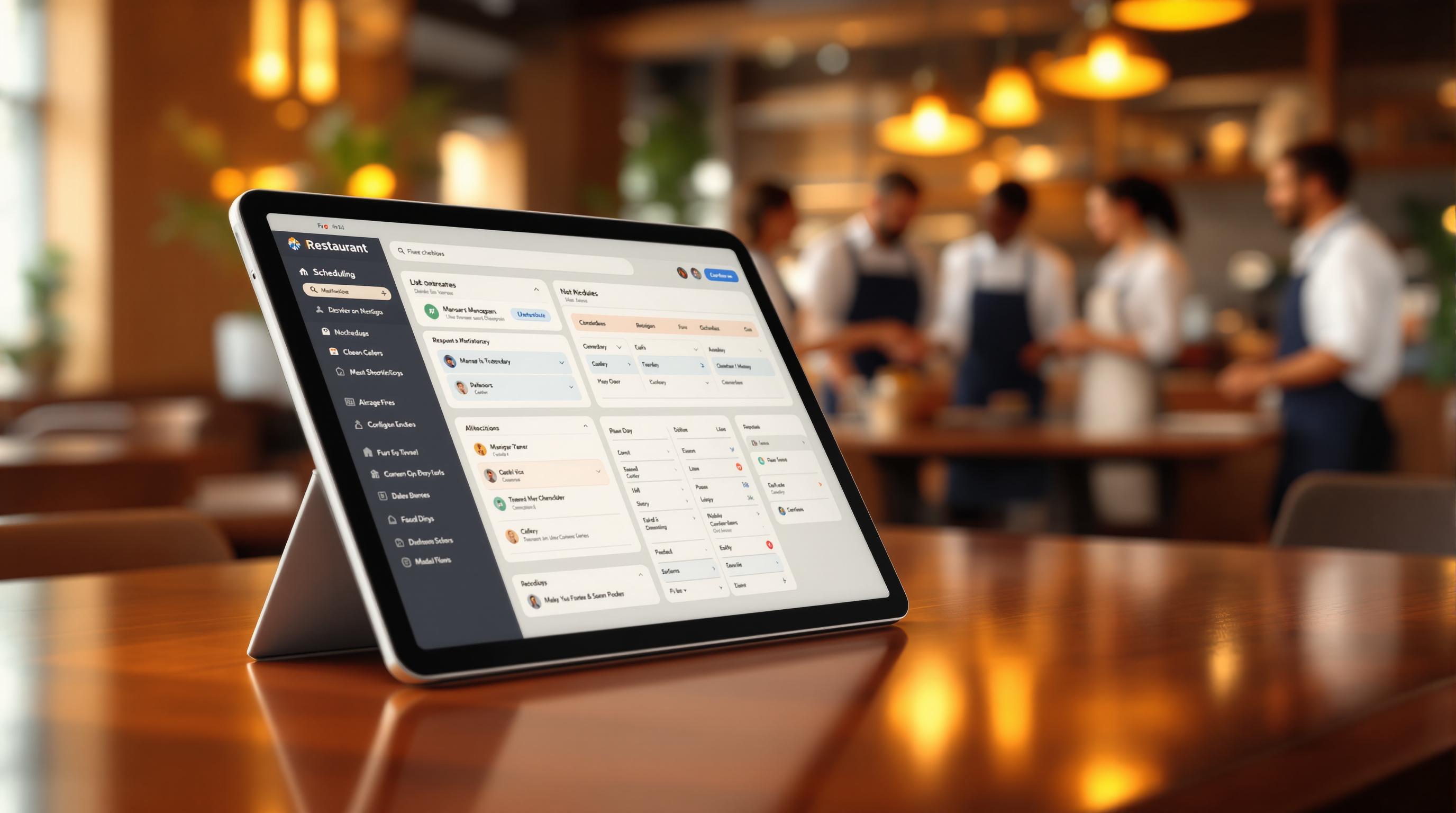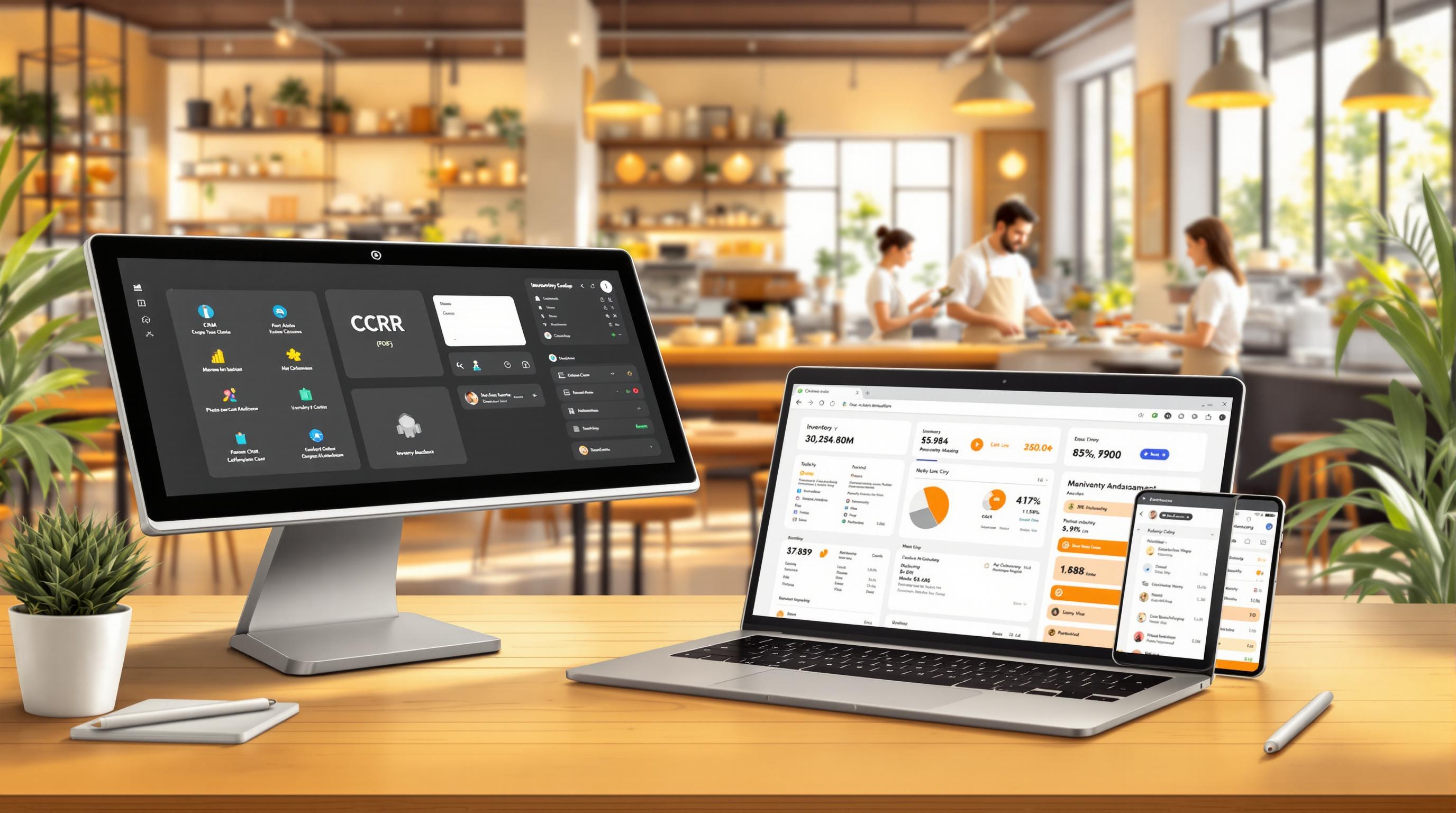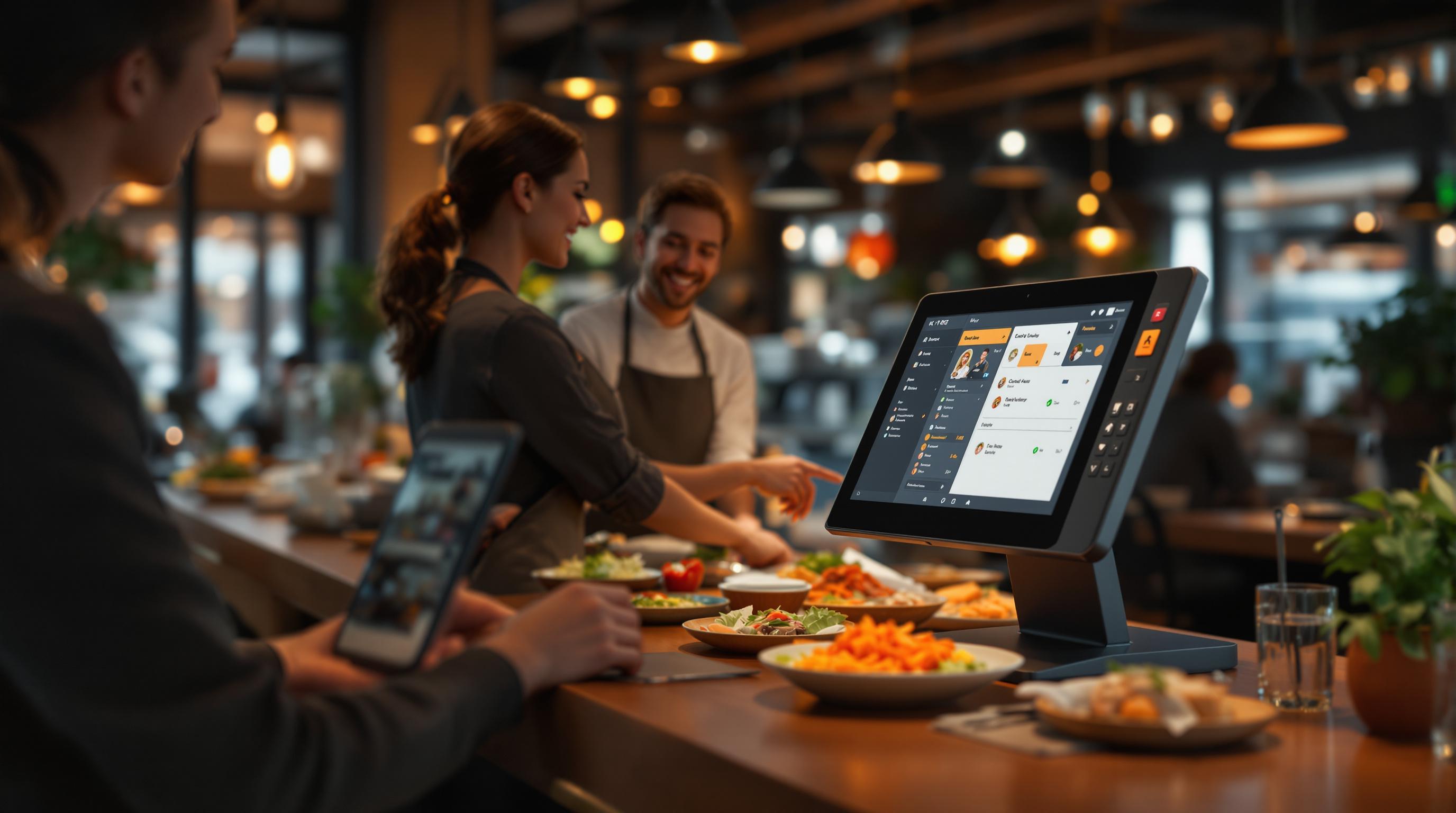The right POS system can simplify operations, save money, and boost efficiency for small restaurants. Here’s a quick summary of the top three options:
- Square POS: Best for new or budget-conscious restaurants with its free plan and easy setup.
- Toast POS: Ideal for sit-down restaurants needing advanced features like table management and detailed reporting.
- Lightspeed Restaurant POS: Great for fast-casual restaurants with iPad compatibility and built-in loyalty tools.
Quick Comparison
| POS System | Best For | Starting Cost | Key Features | Downsides |
|---|---|---|---|---|
| Square POS | Cafes, food trucks, new setups | $0/month | Free plan, real-time inventory, integrations | Limited table management, no training mode |
| Toast POS | Sit-down restaurants | $0/month | Advanced tools, table management, 24/7 support | Higher cost, long-term contract |
| Lightspeed POS | Fast-casual eateries | $69/month | iPad-based, loyalty programs, scalability | Self-guided setup, limited support |
Each system caters to different needs, so choose based on your restaurant type, budget, and growth plans.
Best Restaurant POS System (Top 5 Picks)
1. Square POS Overview

Square POS is designed to tackle common challenges faced by small restaurants, like limited budgets and inventory tracking. Its affordable plans and real-time tools make it a practical choice for smaller operations.
Core Features
Square POS offers a range of tools tailored for restaurants, including:
- Customizable menu layouts
- Real-time inventory tracking
- Automatic discount application
- Built-in payment processing
- Sales analytics and reporting
Pricing Structure
Square POS provides two main pricing options for restaurants:
| Plan Type | Monthly Cost | Processing Fees | Best For |
|---|---|---|---|
| Free Plan | $0/month | 2.6% + $0.10 (in-person) | New restaurants, food trucks |
| Plus Plan | $60/location | 2.6% + $0.10 (in-person) | Growing establishments |
The Plus Plan includes extras like floor plan creation and kitchen display system integration, making it a good fit for restaurants looking to expand.
Hardware and Setup
Square offers flexible hardware options for different budgets. New accounts get free card readers, while countertop terminals range from $299-$799. Additional POS devices are available for $40/month.
Integration Capabilities
Square POS connects easily with key restaurant tools, such as:
- Online ordering platforms
- Accounting software
- Inventory management systems
- Delivery services
Despite its strengths, Square POS has a few downsides. It lacks a training mode, which could slow down staff onboarding. Additionally, its floor plan editing options are limited, which might be inconvenient for restaurants with frequently changing layouts.
Scalability Options
For restaurants planning to grow, Square POS supports multi-location management, advanced reporting, and customizable menus.
Industry experts highlight its suitability for quick-service establishments:
"Square POS is ideal for cafes, bakeries, and food trucks, offering the perfect balance of features and simplicity for quick-service establishments" [1].
While Square POS stands out for its affordability and ease of use, it's worth comparing it to systems like Toast POS, which offer other benefits for small restaurants. Let's dive into how Toast measures up.
2. Toast POS Overview

Toast POS is used by over 112,000 U.S. restaurants, making it one of the top choices for food service businesses. It's designed specifically for restaurants of all sizes, offering tools to streamline operations and improve efficiency.
Key Features
Toast POS is packed with features tailored for restaurants, such as:
- Tools for managing peak times, like order throttling
- Kitchen display systems and real-time inventory tracking
- Table and seat management
- Employee scheduling and payroll tools
- Built-in online ordering capabilities
Pricing Details
| Plan Type | Monthly Cost | Ideal For |
|---|---|---|
| Starter Kit | $0 | Small restaurants with basic needs |
| Core Plan | $69 | Growing businesses needing more features |
| Growth Plan | $165 | Multi-location restaurants |
Payment processing fees start at 2.49% + $0.15 per transaction. The Starter Kit is budget-friendly with its $0 monthly fee, making it a solid option for smaller operations. Hardware costs range from $799.20 for a Handheld Starter Kit to $1,339.20 for a Guest Self-Service Starter Kit. However, hardware can be included at no upfront cost if you're willing to pay higher processing fees.
Hardware and Setup
Toast provides durable, waterproof hardware built on an Android-based system, perfect for restaurant environments. Installation starts at $499, whether done remotely or in person, ensuring everything is set up correctly.
Support and Training
Toast offers 24/7 customer support through phone, email, and chat. They also provide training resources like Toast University and webinars to help users get the most out of the system.
A restaurant owner shared their thoughts:
"We love Toast and its modern, easy-to-use setup. It is very easy for both our employees and customers to utilize" [5].
Integration Options
Toast POS connects seamlessly with other essential tools, including:
- DoorDash for delivery services
- Accounting software
- Inventory management systems
- Employee scheduling tools
- Online ordering platforms
Features for Growth
Toast is designed to grow with your business, offering:
- Multi-location management with detailed reporting
- Advanced menu customization across locations
- Hardware options like handheld devices and self-service kiosks
Industry experts highlight its adaptability:
"Toast is a flexible POS system that can accommodate restaurants, bakeries and cafes of various types and growth profiles" [3].
While Toast is an excellent choice for restaurants looking for scalability and specialized features, there are some considerations. The two-year contract and proprietary payment processing may not suit every business. For small establishments, Lightspeed may offer alternative advantages worth exploring.
sbb-itb-53f0a12
3. Lightspeed Restaurant POS Overview

Lightspeed Restaurant POS is a cloud-based system designed for small restaurants. It runs on iPads, making it both cost-effective and easy to use while offering a range of features to simplify daily tasks.
Key Features
- A quick-serve mode to speed up order processing
- Built-in loyalty program included with all plans
- Inventory tools for creating custom menu items and combos
- Kitchen display systems to improve order coordination
Pricing Structure
| Plan | Monthly Cost | Best For |
|---|---|---|
| Basic | $69 | Single-location restaurants |
| Premium | $165 | Multi-location operations |
Hardware Solutions
Lightspeed works seamlessly with iPads, allowing restaurants to use their existing devices to save on hardware costs. Additional hardware options include:
- Contactless card reader: $69
- Handheld card reader with receipt printer: $389
Integration and Scalability
The system grows with your business, offering tools like:
- Multi-location management
- Advanced inventory features for expanding menus
- Third-party integrations for delivery, accounting, and more
- Detailed reporting across multiple locations
Customer Support and Training
Support is available via phone, email, and chat. However, the onboarding process leans heavily on self-guided learning, requiring users to take a more hands-on approach during setup [3].
"Lightspeed Restaurant POS is a more affordable option with transparent pricing and flexible payment processing fees" [3].
For small restaurants focusing on affordability and essential tools, Lightspeed is worth considering. However, comparing it with other systems like Square and Toast will help determine the best match for your specific needs.
Comparing the Pros and Cons of Each POS System
Here's a closer look at how Square POS, Toast POS, and Lightspeed Restaurant POS stack up for small restaurant operations.
| POS System | Pros | Cons |
|---|---|---|
| Square POS | • Free basic plan • Low transaction fees • Detailed analytics • Wide range of integrations |
• Limited table management tools • Basic inventory features • No training mode • Minimal support for free-plan users |
| Toast POS | • All-in-one management tools • Advanced inventory tracking • Full onboarding support • Excellent table management features |
• Higher cost • Requires proprietary hardware • No free plan • Long-term contract required |
| Lightspeed | • Clear pricing structure • Compatible with iPads • Built-in loyalty programs • Quick-serve mode available |
• Onboarding is self-guided • Limited customer support • Basic feature set • Steeper learning curve |
System Comparison
Square POS works well for small, single-location restaurants due to its budget-friendly features and ease of use. Toast POS is better suited for sit-down restaurants that need a full suite of management tools. Lightspeed offers a middle-ground option, combining reasonable pricing with solid features, though it may require more time to set up and learn.
Hardware and Integration
The hardware options vary widely between these systems. Square offers flexible and affordable hardware, Toast focuses on durable but pricier equipment tailored for busy restaurants, and Lightspeed's iPad compatibility can help reduce upfront costs.
"Toast's comprehensive features and durable hardware make it a top choice for sit-down restaurants, while Square's affordability and ease of use make it ideal for small, single-location businesses" [3][6].
Cost Considerations
Square's free plan and straightforward fees make it an attractive choice for new restaurants. Toast demands a higher investment but delivers advanced tools and features. Lightspeed offers a balanced price point, starting at $69 per month, appealing to those who want solid features without breaking the bank.
For budget-conscious owners, Square POS is a strong option. Restaurants needing advanced tools will find Toast or Lightspeed better suited to their needs. Matching the system to your restaurant's specific requirements ensures you get the most value.
Final Thoughts and Recommendations
After reviewing the top POS systems for small restaurants, some clear options stand out based on different business needs. Square POS is the most cost-effective option, offering essential tools for free. Its intuitive design and no-cost entry point make it a great choice for new or smaller restaurants.
Toast POS is a strong pick for sit-down restaurants looking for advanced features and room to grow. Its wide range of tools and dependable support cater well to businesses with more complex operations or long-term expansion goals [3][6].
Lightspeed Restaurant works well for fast-casual eateries aiming for a balance between cost and functionality. It provides the core features needed without overwhelming users with unnecessary extras.
"Small restaurant owners should consider Square POS for affordability and ease of use, Toast POS for scalability and advanced features, and Lightspeed Restaurant for quick-serve and fast-casual operations" [2][3][4].
Choosing the right POS system comes down to aligning its features with your restaurant's specific needs. Square's straightforward pricing helps you keep costs predictable as you grow. Meanwhile, Toast and Lightspeed offer more tailored solutions for businesses with varying levels of complexity and ambition.
Ultimately, the best choice depends on your current operations, budget, and future plans. Starting with a system that meets your immediate needs while allowing room for growth can set your restaurant up for long-term success.


